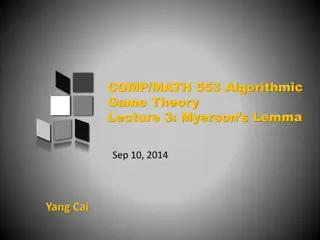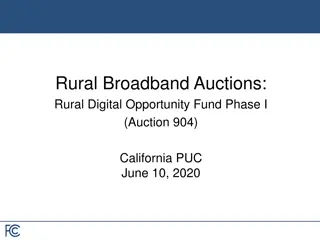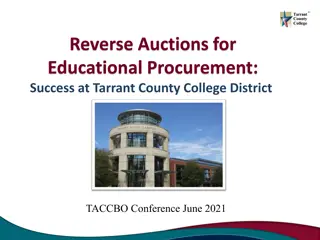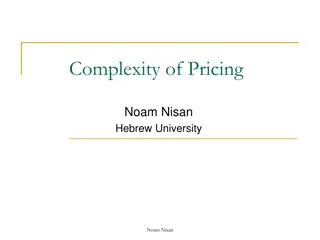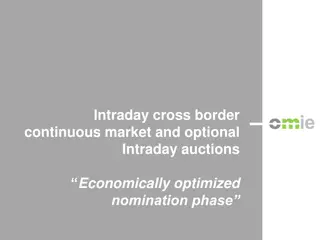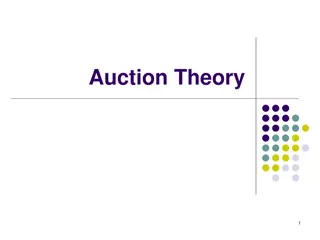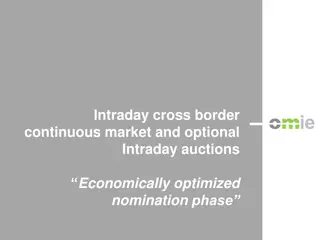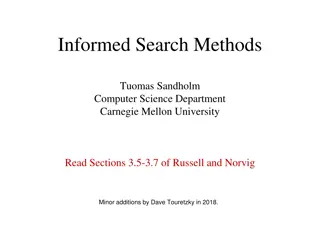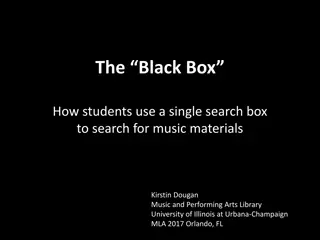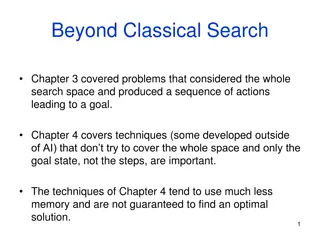Understanding Sponsored Search Auctions: A Comprehensive Overview
Sponsored search auctions play a crucial role in the digital advertising landscape, with major players like Google generating substantial revenue through this model. Advertisers bid on keywords, with positions awarded based on bid amount. The history of keyword auctions dates back to the mid-1990s, evolving to the sophisticated models used today. The assignment market model efficiently allocates positions to maximize value. Market clearing prices determine the cost per position. Explore the intricate workings of keyword auctions through this detailed exploration.
Download Presentation

Please find below an Image/Link to download the presentation.
The content on the website is provided AS IS for your information and personal use only. It may not be sold, licensed, or shared on other websites without obtaining consent from the author. Download presentation by click this link. If you encounter any issues during the download, it is possible that the publisher has removed the file from their server.
E N D
Presentation Transcript
Sponsored Search Auctions 1
2 Traffic estimator
Sponsored Search Auctions Search advertising is a huge auction market Google ad revenue in 2013: $50.5 billion. Hal Varian, Google Chief Economist Most people don t realize that all that money comes pennies at a time. Why would you use auctions in this setting? Difficult to set so many prices (tens of millions of keywords) Demand and especially supply might be changing. Retain some price-setting ability via auction design Today: theory and practice of these auctions An application of the assignment market model! 3
Keyword Auctions Advertisers submit bids for keywords Offer a dollar payment per click. Alternatives: price per impression, or per conversion. Separate auction for every query Positions awarded in order of bid (more on this later). Google uses generalized second price auction format. Advertisers pay bid of the advertiser in the position below. Some important features Value is created by getting a good match of ad to searcher. Multiple positions, but advertisers submit only a single bid. 4
Brief History Mid-1990s: Overture (GoTo) allows advertisers to bid for keywords, offering to pay per click. Yahoo! and others adopt this approach, charging advertisers their bids. Auction design becomes more sophisticated; auctions used to allocate advertising on many webpages, not just search. 1990s: websites sell advertising space on a per-eyeball basis, with contracts negotiated by salespeople; similar to print or television. 2000s: Google and Overture modify keyword auction to have advertisers pay minimum amount necessary to maintain their position (GSP). 5
Assignment Model Positions k = 1, ,K Bidders n = 1, ,N Position k gets xk clicks per day: x1 > x2> > xK Bidder n has value vn per click: v1 > v2> > vN. Bidder n s value for position k is: vn* xk. Bidder n s profit if buys k, pays pk per click: (vn-pk)*xk. Efficient, or surplus maximizing, assignment is to give position 1 to bidder 1, position 2 to bidder 2, etc. 6
Example Two positions: receive 200 and 100 clicks per day Bidders 1,2,3 have per-click values $10, $4, $2. Top 2000 800 400 2nd 1000 400 200 Bidder 1 Bidder 2 Bidder 3 Efficient allocation creates value $2400 Bidder 1 gets top position: value 200*10 = 2000 Bidder 2 gets 2nd position: value 100*4 = 400 7
Market Clearing Prices Solve for the market clearing per-position prices Top 2000 800 400 2nd 1000 400 200 Bidder 1 Bidder 2 Bidder 3 Lowest market clearing prices: 600 and 200 Bidder 1 prefers top position Bidder 2 prefers 2nd position Bidder 3 demands nothing. 8
Per Click Prices Market clearing position prices are 600 and 200. Positions receive 200 and 100 clicks per day This equates to $3 and $2 per click for the two positions. Check: per-click prices p1 = 3, p2 = 2 clear the market Bidder 3 wants nothing: value is only $2 / click. Bidder 2 wants position 2: 100*(4-2) >= 200*(4-3) Bidder 1 wants position 1: 200*(10-3) > 100*(10-2) Efficient outcome with revenue: $600+$200= $800 9
Find All Market-Clearing Prices Positions get 200 and 100 clicks. Bidder per click values 10, 4, 2. Bidder 3 demands nothing: p1 2 and p2 2 Bidder 2 demands position 2: p2 4 and 2p1 4+p2 Prefers 2 to nothing: 100*(4-p2) 0 Prefers 2 to 1: 200*(4- p1) 100*(4- p2) Bidder 1 demands position 1: 2p1 10 + p2 Prefers 1 to nothing: 200*(10-p1) 0 (redundant) Prefers 1 to 2: 200*(10 - p1) 100*(10 - p2) 10
Market Clearing Prices p1 Revenue = 200p1 + 100p2 8 6 p1 2+(1/2)p2 p1 5+(1/2)p2 4 2 p2 4 2 Note that p1 p2 2 4 p2 11
Price Premium for More Clicks At market clearing prices, bidder k wants to buy k Therefore bidder k prefers position k to position k-1 (vk- pk)*xk (vk pk-1)*xk-1 We know that vk pk and also that xk-1 xk. Therefore, it must be the case that pk-1 pk. Per-click prices must be higher for better positions 12
Finding Market Clearing Prices Suppose more bidders than positions, so N>K. Set pKso that bidder K+1 won t buy: pK = vK+1 Set pk so that bidder k+1 will be just indifferent between position k+1 and buying up to position k: (vk+1 pk)*xk = (vk+1 pk+1)*xk+1 This works as an algorithm to find lowest clearing prices. To find highest market clearing prices, set pK=vK and set pk so that bidder k is just indifferent between k and k+1. 13
Sponsored Search Auctions Can we design an auction to find market clearing prices? The auctions we studied before for the assignment market require relatively complex bids (each bidder must bid separately for each of the K positions or items). Ideally want to use the structure of the problem to design a simpler auction. We ll consider several options. 14
Pay-As-Bid Auction Overture Pay-as-Bid Auction Each bidder submits a single bid (in $ per click) Top bid gets position 1, second bid position 2, etc. Bidders pay their bid for each click they get. 15
Example: Pay-as-Bid Two positions: receive 200 and 100 clicks per day Bidders 1,2,3 have per-click values $10, $4, $2. Overture auction (pay as bid) Bidder 3 will offer up to $2 per click Bidder 2 has to bid $2.01 to get second slot Bidder 1 wants to bid $2.02 to get top slot. But then bidder 2 wants to top this, and so on. Pay as bid auction is unstable! 16
Overture bid patterns Edelman & Ostrovsky (2006): sawtooth pattern caused by auto-bidding programs. 17
Google GSP Auction Generalized Second Price Auction Bidders submit bids (in $ per click) Top bid gets slot 1, second bid gets slot 2, etc. Each bidder pays the bid of the bidder below him. Seems intuitively like a more stable auction. Do the bidders want to bid truthfully? 19
Truthful bidding? Not a dominant strategy to bid truthfully ! Example: two positions, with 200 and 100 clicks. Consider bidder with value 10 Suppose competing bids are 4 and 8. Bidding 10 wins top slot, pay 8: profit 200 2 = 400. Bidding 5 wins next slot, pay 4: profit 100 6 = 600. If competing bids are 6 and 8, better to bid 10 20
Example: GSP auction Recall bidder values 10, 4, 2, and clicks 200 and 100. In this example, it is a Nash equilibrium to bid truthfully. Verifying the Nash equilibrium with bids 10, 4, 2. Bidder 3 would have to pay $4 to get slot 2 not worth it. Bidder 2 is willing to pay $2 per click for position 2, but would have to pay $10 per click to get position 1 not worth it. Bidder 1 could bid below $4 and pay $2 for the lower slot, rather than $4 for the top, but wouldn t be profitable. Prices paid per click in this NE are 4 and 2. Payments are 200*4 + 100*2 = 1000. 21
GSP equilibrium prices p1 GSP prices are also competitive equilibrium prices! 8 6 GSP eqm 4 Not the only GSP equilibrium, however 2 2 4 p2 22
Example: GSP auction Recall bidder values 10, 4, 2, and clicks 200 and 100. Another Nash equilibrium of the GSP (w/ higher prices) Bidder 1 bids $6, Bidder 2 bids $5, Bidder 3 bids $3. Verifying the Nash equilibrium Bidder 3 doesn t want to pay $5 or more to buy clicks Bidder 2 is willing to pay $3 per click for the second position but doesn t want to pay $6 per click for position 1. Bidder 1 prefers to pay $5 for top position rather than $3 for bottom position because 200*(10-5) > 100*(10-1). Prices in this equilibrium are $5 and $3. 23
Example: GSP auction Recall bidder values 10, 4, 2, and clicks 200 and 100. Yet another GSP equilibrium w/ lowest clearing prices! Bidder 1 bids $10, Bidder 2 bids $3, Bidder 3 bids $2 Verifying the Nash equilibrium Bidder 3 doesn t want to pay $3 or more for clicks Bidder 2 doesn t want to pay $10 per click to move up. Bidder 1 pays $3 for top position, better than $2 for bottom because profits are 200*(10-3) > 100*(10-2). In this equilibrium, per-click prices are $3 and $2. 24
GSP equilibrium prices p1 Claim: For every competitive equilibrium there is a corresponding GSP equilibrium. 8 6 GSP eqm GSP eqm 4 2 2 4 p2 25
Finding GSP Equilibria Fix a set of market clearing per-click prices: p1, ,pN There is a corresponding GSP equilibrium in which: Bidder 1 can bid anything Bidder 2 bids p1 Bidder 3 bids p2 Etc. Bidder k will prefer to buy position k and pay pk rather than buying position m and paying pm --- that s why the prices were market clearing! Note: we re assuming here that N>K (enough bidders). 26
Vickrey Auction Bidders submit bids ($ per-click) Seller finds assignment that maximizes total value Puts highest bidder in top position, next in 2nd slot, etc. Charges each winner the total value their bid displaces. For bidder n, each bidder below n is displaced by one position, so must add up the value of all these lost clicks. Facebook uses a Vickrey auction. Dominant strategy to bid one s true value. 27
Vickrey Auction Pricing Order per-click bids: b1>b2> >bN With bidder k b1 No Position 1 Bidder k b1 Consider bidder who wins kth slot. Displaces k+1, ,K. Leaves 1, ,k-1 intact. 2 b2 b2 k-1 bk-1 bk-1 Displaced bidder j would get xj-1 clicks in position j-1, but instead gets xj clicks in position j. k bk bk+1 k+1 bk+1 bk+2 Bidder k pays: ?>????? 1 ?? K bK bK+1 Note: in GSP k pays: ??+1?? 28
Vickrey Auction Example Recall bidder values 10, 4, 2, and clicks 200 and 100. Vickrey payment for Bidder 2 Bidder 2 displaces 3 from slot 2 Value lost from displacing 3: $2 * 100 = $200 So Bidder 2 must pay $200 (for 100 clicks), or $2 per click. Vickrey payment for Bidder 1 Displaces 3 from slot 2: must pay $200 Displaces 2 from slot 1 to 2: must pay $4*(200-100)=$400 So Bidder 1 must pay $600 (for 200 clicks), or $3 per click. Vickrey prices are p2 = 2 and p1 = 3, revenue $800. 29
Vickrey prices p1 Vickrey prices are the lowest competitive equilibrium prices! 8 6 4 Vickrey prices 2 Revenue = 200*3+100*2=800 2 4 p2 30
Summary of Auction Results Result 1. The generalized second price auction (GSP) does not have a dominant strategy to bid truthfully. Result 2. The Nash Equilibria of the GSP are equivalent to the set of competitive equilibria*: Bidders obtain their surplus-maximizing positions For any NE of the GSP, the prices paid correspond to market clearing prices, and for any set of market clearing prices, there is a corresponding NE of GSP. Result 3. The Vickrey auction does have a dominant strategy to bid truthfully, and the payments correspond to the lowest market-clearing position payments. 31 *Small caveat here: there are also some weird NE of the GSP that I m ignoring.
Keyword Auction Design Platforms do retain some control over prices Restricting the number of slots can increase prices. Setting a reserve price can increase prices Platforms can also quality-adjust bids In practice, ads that are more clickable get promoted. Bids can be ranked according to bid * quality. This gives an advantage to high-quality advertisements. 32
Example: Reserve Prices Two positions with 200, 100 clicks Three bidders with values $2, $1, $1 Baseline: focus on lowest market clearing prices Bottom position sells for $1 / click => revenue $100 Top position sells for $1 / click => revenue $200. Can the seller benefit from a reserve price? No reserve price: revenue of $300. Reserve price of $2: revenue of $400 Sell only one position, but for $2 per click! 33
Quality Scoring Suppose that instead of any bidder getting xk clicks in position k, bidder n can expect to get an*xk clicks. If a bidder has a high an, its ad is clickable . In practice, Google and Bing run giant regressions to try to estimate the clickability of different ads. Then bids in the auction can be ranked by an*bn, which means that clickable ads get prioritized in the rankings. This can have advantages and disadvantages Puts weight on what users want and rewards higher quality ads. Sometimes can reduce revenue if one ad gets lots of clicks. 34
Sponsored vs organic results Google and Bing show organic search results on the left side of the page and sponsored results on the right. The assignment of positions on the page is different Organic search results: use algorithm to assess relevance Sponsored search results: use bids to assess value To some extent there is competition If a site gets a good organic position, should it pay for another? Search engines have to think about maximizing user experience but also about capturing revenue from advertisers tricky. 35
Sponsored Search Summary Search auctions create a real-time market in which advertising opportunities are allocated to bidders. Auction theory suggests why the second-price rules used in practice might be reasonably efficient. GSP does not induce truthful bidding but it has efficient Nash equilibria with competitive prices. Vickrey auction does induce truthful bidding, but prices depend on a more complicated formula. In practice, the search platforms have a fair amount of scope to engage in optimal auction design. 36


